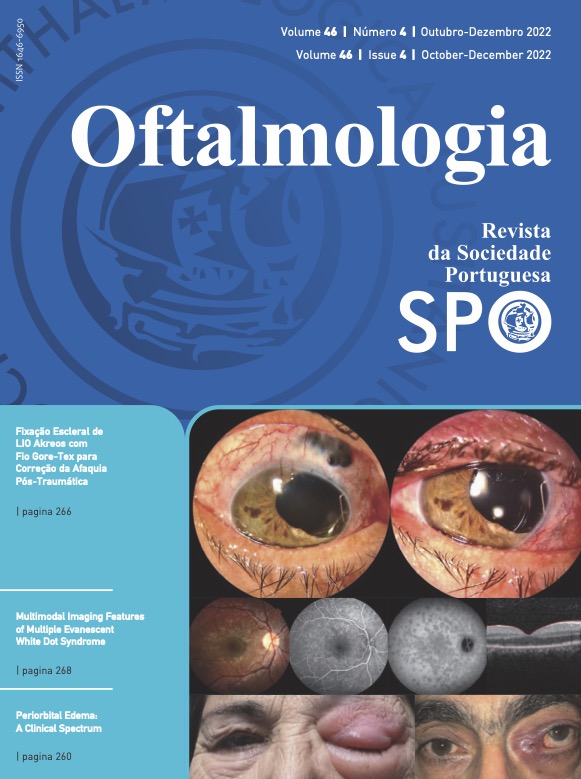Sickle Cell Retinopathy: Characterization of a Pediatric Population by Multimodal Imaging
DOI:
https://doi.org/10.48560/rspo.25974Keywords:
Anemia, Sickle Cell/complications, Eye Manifestations, Multimodal Imaging, Retinal Diseases/diagnosisAbstract
INTRODUCTION: Retinopathy is the most frequent ophthalmological manifestation of sickle cell disease (SCD). Advances in retinal multimodal imaging have revealed the presence of retinopathy in asymptomatic patients. The present study aims to characterize the typical retinal changes by multimodal imaging in a pediatric population with SCD, allowing the non-invasive observation of the vascular effects of the disease.
MATERIAL AND METHODS: Observational study that included children diagnosed with SCD referred from the Pediatric Hematology consultation at Hospital Garcia de Orta. The evaluation consisted of a complete ophthalmologic evaluation and multimodal imaging: wide-field fundus photography (Zeiss CLARUS 700), optical coherence tomography (OCT) and OCT- angiography (OCT-A) (Zeiss Cirrus HD-OCT 5000), with particular interest in the assessment of the vascular zone area and superficial macular vascular flow and density.
RESULTS: Our study included 28 children with SCD, mean age 12.33 ± 3.19 years, 16 (57%) female and 12 (43%) male. The most frequent genotype was SS (26 patients). Of the 56 eyes evalu- ated, 20 (36%) had non-proliferative retinopathy and 1 (1.8%) had proliferative retinopathy. The most frequently detected retinal change was the sunburst lesion (9 eyes, 16%). Also noteworthy is the presence of dark without pressure lesions in 4 eyes (2%). There was a statistically significant difference (p<0.05) between external macular superficial vascular density and the presence of retinopathy.
CONCLUSION: The present study revealed that the external macular superficial vascular density was lower in patients with retinopathy. On the other hand, the most frequent retinal finding was the sunburst lesion, in line with what was reported in previous studies.
Downloads
References
Amissah-Arthur KN, Mensah E. The past, present and future management of sickle cell retinopathy within an African context. Eye. 2018;32:1304-14. doi: 10.1038/s41433-018-0162-8.
Abdalla Elsayed MEA, Mura M, Al Dhibi H, Schellini S, Malik R, Kozak I, Schatz P. Sickle cell retinopathy. A focused review. Graefes Arch Clin Exp Ophthalmol. 2019;257:1353-64. doi: 10.1007/s00417-019-04294-2.
Do BK, Rodger DC. Sickle cell disease and the eye. Curr Opin Ophthalmol. 2017;28:623-8. doi: 10.1097/ ICU.0000000000000423.
Bonanomi MT, Lavezzo MM. Sickle cell retinopathy: diagnosis and treatment. Arq Bras Oftalmol. 2013;76:320-7. doi: 10.1590/s0004-27492013000500016.
Pahl DA, Green NS, Bhatia M, Chen RW. New Ways to Detect Pediatric Sickle Cell Retinopathy: A Comprehensive Review. J Pediatr Hematol Oncol. 2017;39:618-25. doi: 10.1097/ MPH.0000000000000919.
Ghasemi Falavarjani K, Scott AW, Wang K, Han IC, Chen X, Klufas M, et al. Correlation of multimodal imaging in sickle cell retinopathy. Retina. 2016;36:S111-7. doi: 10.1097/ IAE.0000000000001230.
Early Treatment Diabetic Retinopathy Study Research Group. Grading Diabetic Retinopathy from Stereoscopic Color Fundus Photographs - An Extension of the Modified Airlie House Classification: ETDRS Report Number 10. Ophthalmology. 2020;127:S99-S119. doi: 10.1016/j.ophtha.2020.01.030.
AlRyalat SA, Nawaiseh M, Aladwan B, Roto A, Alessa Z, Al-Omar A. Ocular manifestations of sickle cell disease: signs, symptoms and complications. Ophthalmic Epidemiol. 2020;27:259-64. doi: 10.1080/09286586.2020.1723114.
Asdourian G, Nagpal KC, Goldbaum M, Patrianakos D, Goldberg MF, Rabb M. Evolution of the retinal black sunburst in sickling haemoglobinopathies. Br J Ophthalmol. 1975;59:710- 6. doi: 10.1136/bjo.59.12.710.
Flores Pimentel MA, Duncan JL, de Alba Campomanes AG, Moore A. Dark without pressure retinal changes in a paediatric age group. Eye. 2021;35:1221-7. doi: 10.1038/s41433-020- 1088-5.
Linz MO, Scott AW. Wide-field imaging of sickle retinopathy. Int J Retina Vitreous. 2019;5:27. doi: 10.1186/s40942-019-0177-8.
Mathew R, Bafiq R, Ramu J, Pearce E, Richardson M, Drasar E, et al. Spectral domain optical coherence tomography in patients with sickle cell disease. Br J Ophthalmol. 2015;99:967-72.
doi: 10.1136/bjophthalmol-2014-305532.
Wang M, Hussnain SA, Chen RWS. The Role of Retinal Imaging in Sickle Cell Retinopathy: A Review. Int Ophthalmol Clin. 2019;59:71-82. doi: 10.1097/IIO.0000000000000255.
Talbot JF, Bird AC, Maude GH, Acheson RW, Moriarty BJ, Serjeant GR. Sickle cell retinopathy in Jamaican children: further observations from a cohort study. Br J Ophthalmol. 1988;72:727-32. doi: 10.1136/bjo.72.10.727.
Pahl DA, Green NS, Bhatia M, Lee MT, Chang JS, Licursi M, et al. Optical Coherence Tomography Angiography and Ultra-widefield Fluorescein Angiography for Early Detection of Adolescent Sickle Retinopathy. Am J Ophthalmol. 2017;183:91- 98. doi: 10.1016/j.ajo.2017.08.010.
Ribeiro MV, Jucá JV, Alves AL, Ferreira CV, Barbosa FT, Ribeiro EA. Sickle cell retinopathy: A literature review. Rev Assoc Med Bras. 2017;63:1100-3. doi: 10.1590/1806-9282.63.12.1100.
Downloads
Published
How to Cite
Issue
Section
License
Copyright (c) 2022 Revista Sociedade Portuguesa de Oftalmologia

This work is licensed under a Creative Commons Attribution-NonCommercial 4.0 International License.
Do not forget to download the Authorship responsibility statement/Authorization for Publication and Conflict of Interest.
The article can only be submitted with these two documents.
To obtain the Authorship responsibility statement/Authorization for Publication file, click here.
To obtain the Conflict of Interest file (ICMJE template), click here





